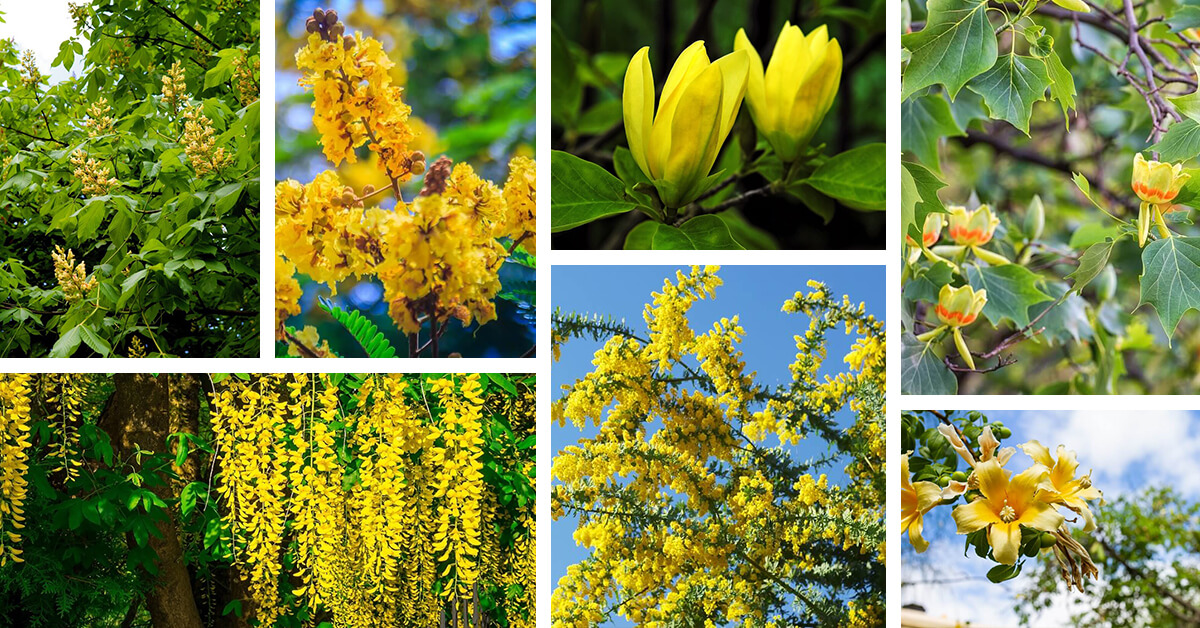Mirroring sunshine, trees with yellow flowers bring a glow to the garden from the top down. Yellow flowers, especially from blooming trees, bring joy to the garden.
Below, you will find trees with giant yellow flowers such as the Yellow Silk Floss Tree. For radiant glowing yellow color, trees with massive clusters of tiny yellow flowers make a huge impact too, like the Golden Raintree. The vibrancy and energy of yellow is so precious in spring-blooming trees. You will find favorite spring-blooming trees with yellow flowers below such as Cornelian Cherry and Tulip Tree. There are winter bloomers too, like Witch Hazel and some even bloom year-round including Sweet Acacia.
Enjoy finding out more about yellow-flowering trees on our list below.
Key Takeaways
- There is an incredibly surprising assortment of trees with yellow flowers.
- Of the many types of yellow-flowering trees, there is a great choice for every region.
- In the desert, some yellow-flowering trees thrive, while others may flourish in tropical environments.
- Some trees with yellow flowers are native to the USA, while others have origins from around the world.
- Yellow-flowering trees range in size, but on average, they are about 25 to 40 feet tall.
Sunny Yellow-Flowering Trees for Glowing Warmth in The Landscape
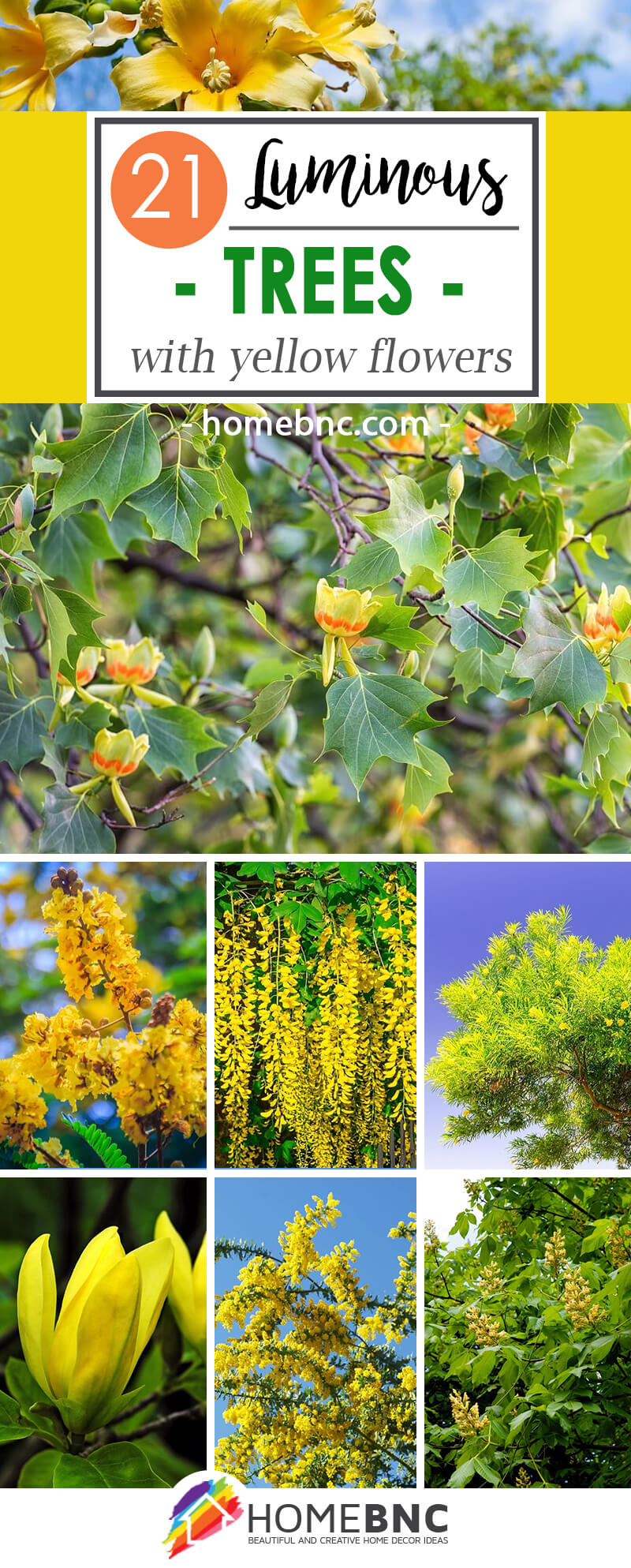
1. Tulip Tree (Liriodendron tulipifera)
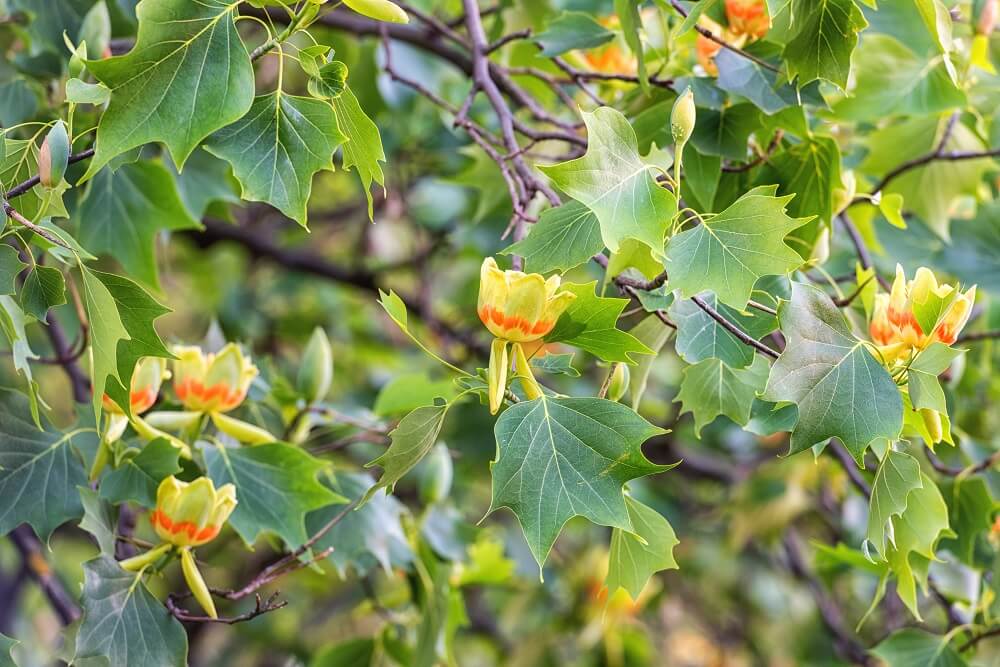
One of North America’s largest native trees, the Tulip Tree bears magnificent flowers from May to June. The tulip-like blooms are bright yellow with an orange band at the base of each petal, making them even more striking.
Growing to heights of 60 to 90 feet with a spread of 30 to 50 feet, the Tulip Tree trunk may be 4 to 6 feet across. From the Magnolia family of plants, Tulip Tree’s native range spreads from Massachusetts to Wisconsin and south to Florida and Mississippi. Notably, this is the state tree for Indiana, Tennessee, and Kentucky. Found in USDA zones 4 to 9, this yellow-flowering tree makes an excellent shade tree, particularly in large landscapes.
While Tulip Trees attract birds and hummingbirds, they are also tolerant of heavy wet soils as well as deer and rabbits.
2. Linden Tree – American Basswood (Tilia americana)
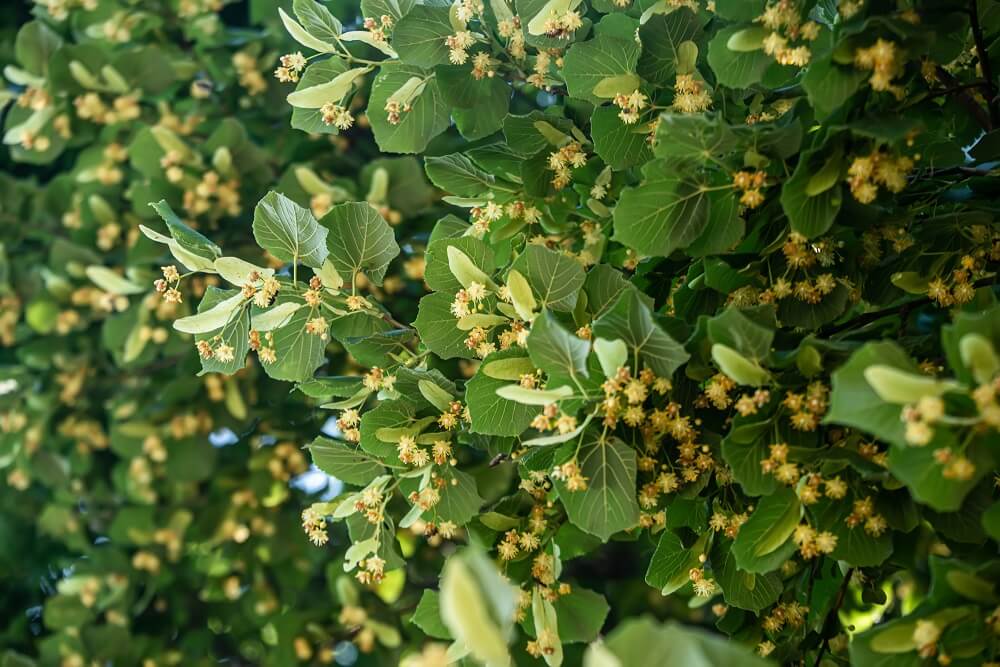
American Basswood is also known as American Linden. A true North American native tree with fragrant yellow flowers in June. The showy flowers and subsequent pea-sized nutlets attract birds and butterflies and American Linden help support other wildlife as well.
Very cold hardy, this yellow-flowering tree is hardy in USDA zones 2 to 8 and makes a wonderful flowering shade tree.
Found in rich woodlands and along streams, American Basswood. Its native range is from southern Canada through to Oklahoma, Tennessee, and North Carolina. It is used in conservation projects, riparian plantings, and makes an excellent windbreak.
3. Cornelian Cherry (Cornus mas)
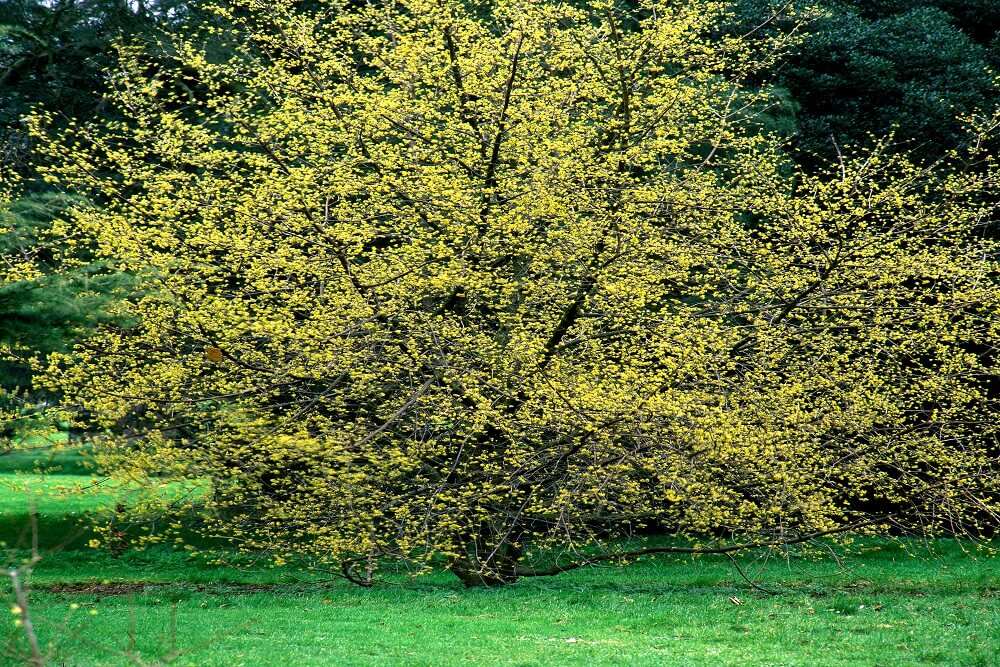
Cornelian Cherry is a dogwood species with clusters of bright yellow flowers that burst from the branches in early spring, even before the leaves appear. Not only do Cornelian Cherry have gorgeous blossoms to help shake off the winter blues, but it also has interesting exfoliating bark throughout winter.
In summer, the dark green, glossy leaves are the perfect backdrop for the deep red, oval fruits that have excellent wildlife value for birds and squirrels. The fruit is edible for people too and has been cultivated as a fruit crop for centuries.
A European native plant, this small tree has been introduced in the USA. It grows up to 25 feet tall and 20 feet wide. This early bloomer is long living and provides four seasons of interest.
4. Yellow Tabebuia / Golden Trumpet (Handroanthus chrysotrichus)
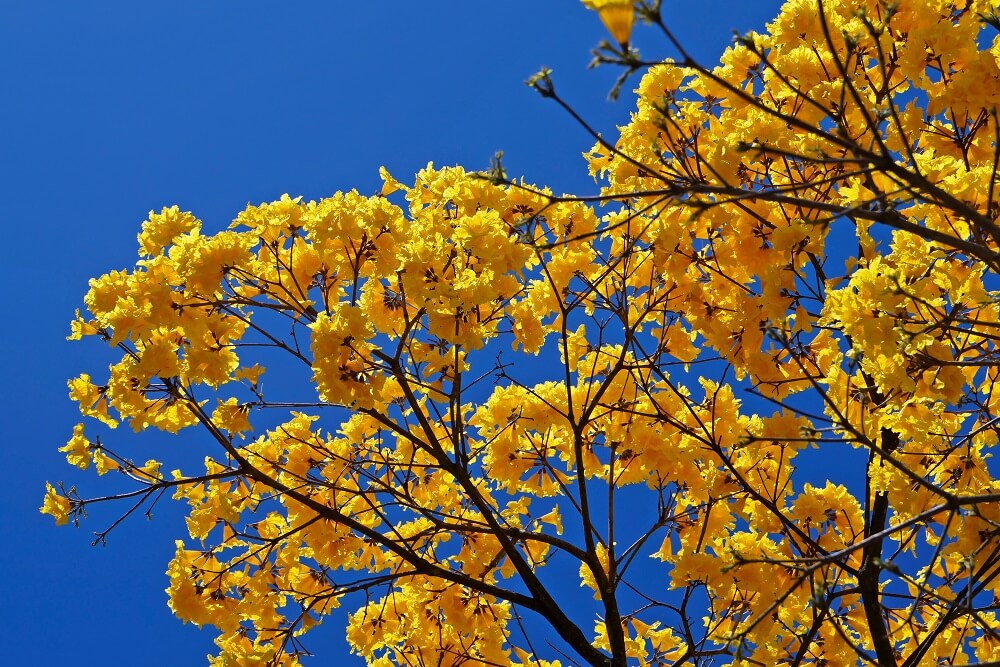
The trumpet-shaped flowers emerge in spring during a brief time where the tree loses its 4-inch, palmate, silver-colored leaves.
Individually, the flowers are spectacular, but flowers are produced in large groups or clusters. These flower clusters, bold against the bear branches, can be up to 8 inches long. Each tubular flower becomes a long, furry golden-red, interesting seedpod shortly after flowering.
A fast-growing tree, Golden Trumpet reaches 25 to 35 feet tall and wide. A fantastic specimen or street tree, this yellow-flowering tree is known for its drought tolerance, once established.
5. Yellow Bird Magnolia (Magnolia ‘Yellow Bird’)
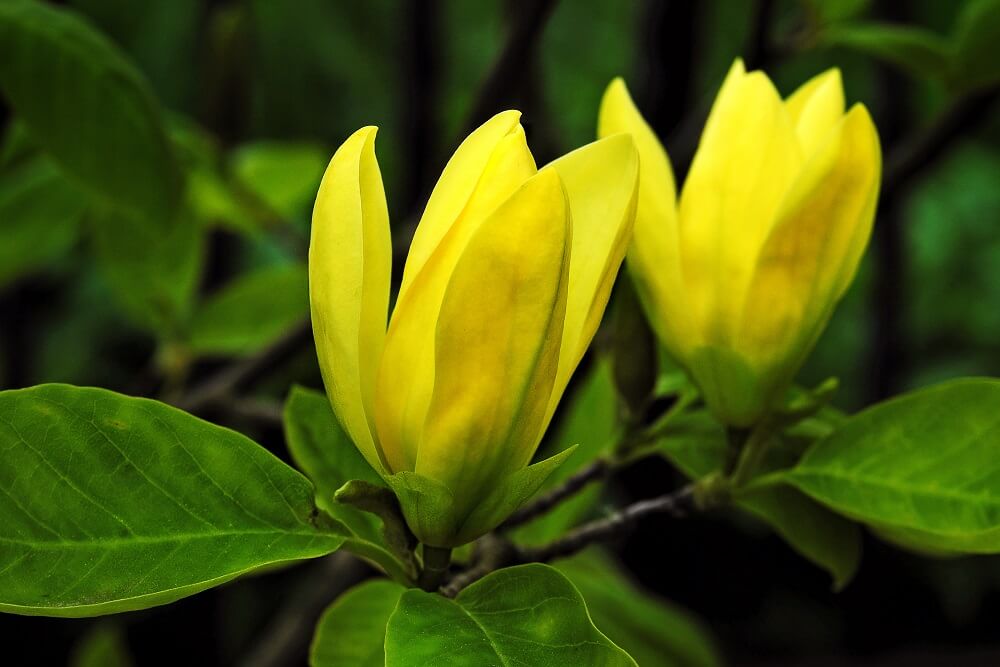
From creamed butter to electric gold, Magnolia trees come in an exceptional range of yellow flowers. Our pick is the Yellow Bird Magnolia for its pale-yellow flowers in spring. The showy flowers are stunning with a delightful fragrance. Before the leaves emerge, large yellow cup-shaped flowers are held on top of the branches. The large leaves that follow are dark green and pointed. They turn copper to bronze in fall. Early fall, the Yellow Bird Magnolia tree displays its fruit of attractive pink pods.
Yellow Bird Magnolia does best in full sun, where it will produce the most flowers. This large tree is hardy in USDA hardiness zone 5 to 10. Surprisingly large, Yellow Bird Magnolia can gain a height of 40 feet and a gorgeous canopy spread of 30 feet wide.
6. Witch Hazel (Hamemelis x intermedia)
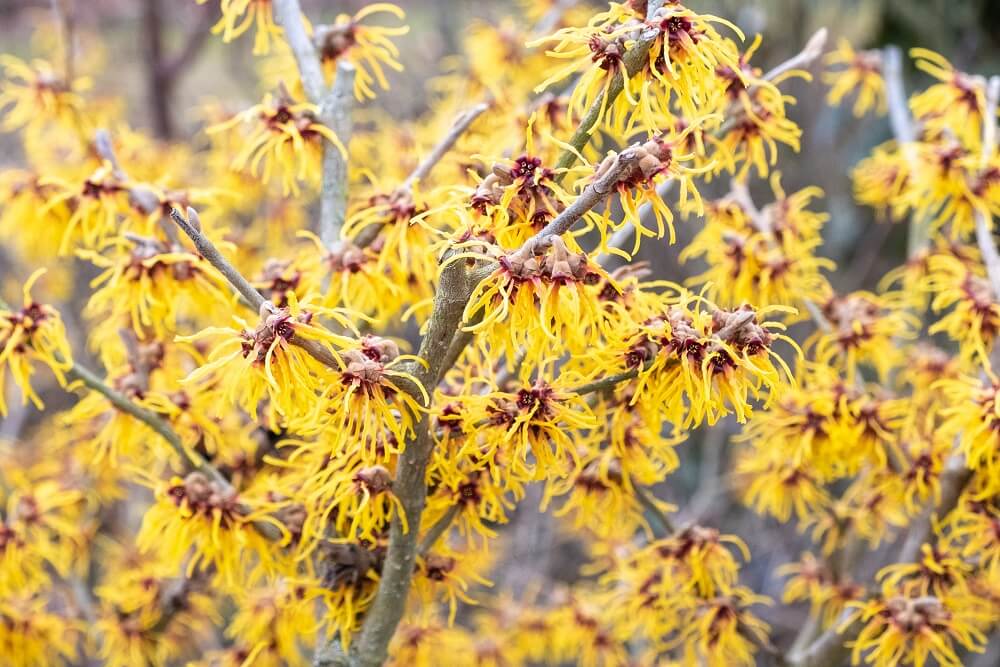
Wonderfully weird Witch Hazel has one of the earliest blooming, unique looking flowers. Witch Hazel has an upright vase-shape with open spreading branches that are smothered in flowers of ribbon-like petals in late winter.
The intoxicating fragrance, most precious at winter’s end, makes Witch Hazel an excellent specimen tree. It grows 15 to 20 feet tall and is hardy in USDA zones 5 to 9. It needs a bit of extra space but is also spectacular when grown in groups.
Available in colors ranging in yellow, red, and orange, there are a few notable, yellow-flowered varieties. “All Gold” has yellow petals surrounding a deep purple calyx. Another favorite is “Arnold’s Promise” which, in addition to the clear yellow flowers in late winter, also has an excellent fall leaf color show of yellow, orange, and red.
7. Golden Raintree (Koelreuteria paniculata)
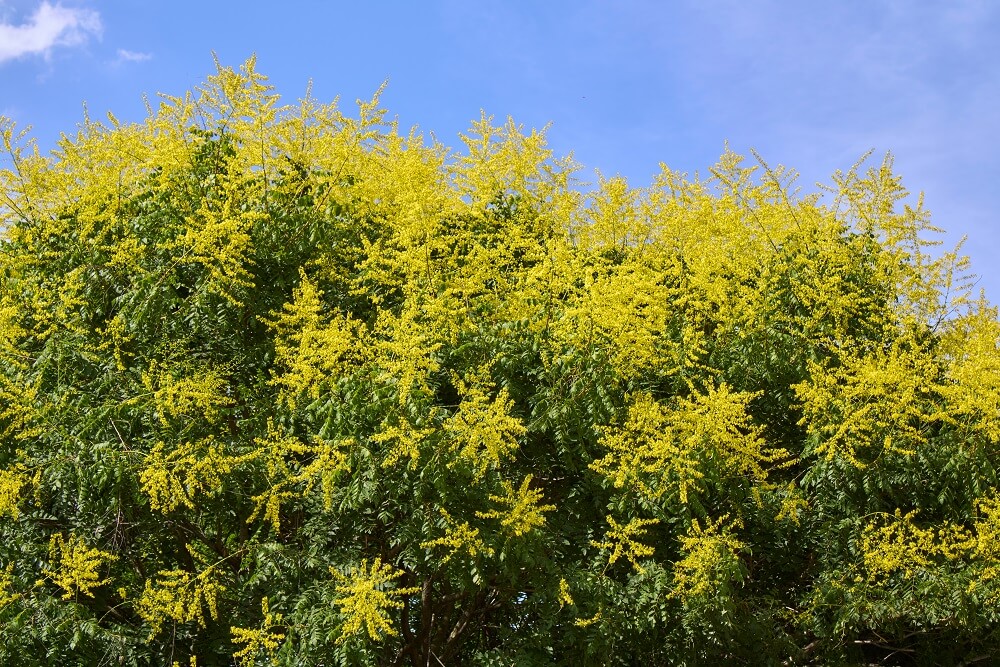
This summer-blooming tree has gold upright 12-to-15-inch panicles made of masses of tiny star-shaped yellow flowers. Golden Raintree sheds a golden carpet of petals, which is how it received its common name.
At bloom time, this tree is a welcome nectar source for roaming pollinators. And, Golden Raintree, while an excellent yellow-flowering tree, is also a valuable shade tree, street tree, or gorgeous specimen tree. Moreover, it is resistant to drought, pollution, deer, heat, and wind. Golden Raintree is a happy alternative to invasive options such as Tree of Heaven, (Ailanthus altissima).
Introduced to the USA and Europe, Golden Raintree originates from Asia. It grows in USDA zones 6 to 9 and may reach 30 to 40 feet high and wide.
8. Yellow Buckeye (Aesculus flava)
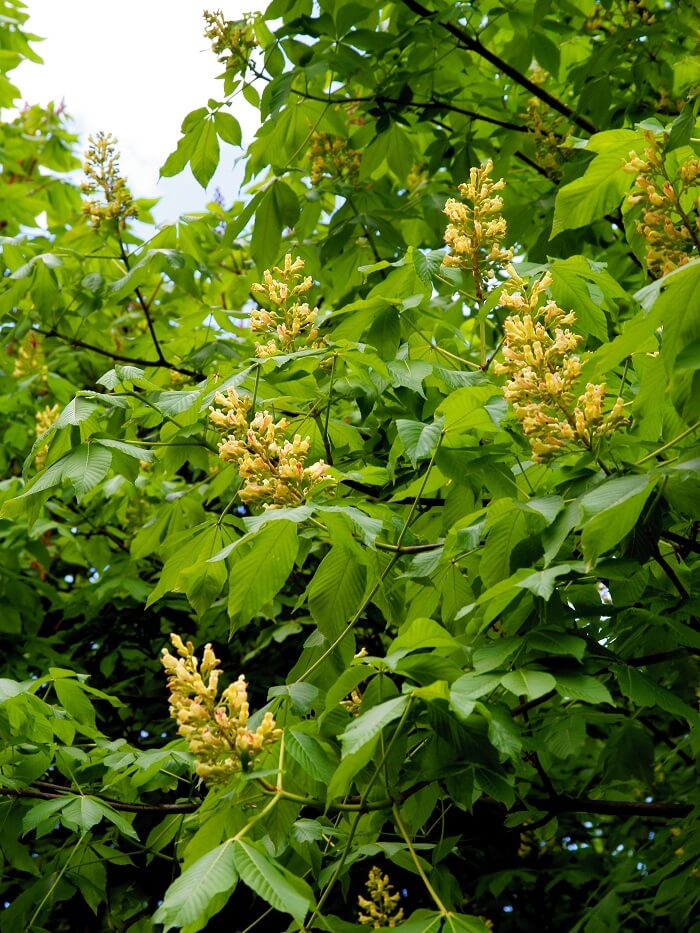
Large upright panicles can be up to 7 inches long when Yellow Buckeye blooms in spring. A North American native, Yellow Buckeye can grow 90 feet tall. It is a great choice for naturalized areas, open woodlands, and planting close to waterways such as ponds or streams.
The individual creamy yellow flowers produce 2-to-3-inch fruits which can be messy. They are also high in saponins and come with a poisonous warning if not treated appropriately.
Hardy in USDA zones 3 to 8, Yellow Buckeye is found in the Eastern USA. Trunks can be 3 feet across with the tree forming an attractive oval crown.
9. Golden Shower Tree (Cassia fistula)

Unlike the Golden Rain Tree that has upright panicles, the Golden Shower Tree has huge pendulous flower clusters that mature into large seedpods. The 2-foot-long seedpods are dark brown and cylindrical. They persist on the tree, adding interest during winter.
Golden Shower Tree is fast growing in USDA hardiness zones 10b to 11. Originating in India, Malaysia, and Southeast Asia, this tree with yellow flowers grows 30 to 40 feet tall and wide. With its gorgeous pinnately compound leaves, cascades of yellow flowers, and interesting seedpods, Golden Shower Tree makes an excellent shade tree, street tree, or lawn specimen.
10. Yellow Palo Verde (Parkinsonia microphylla)
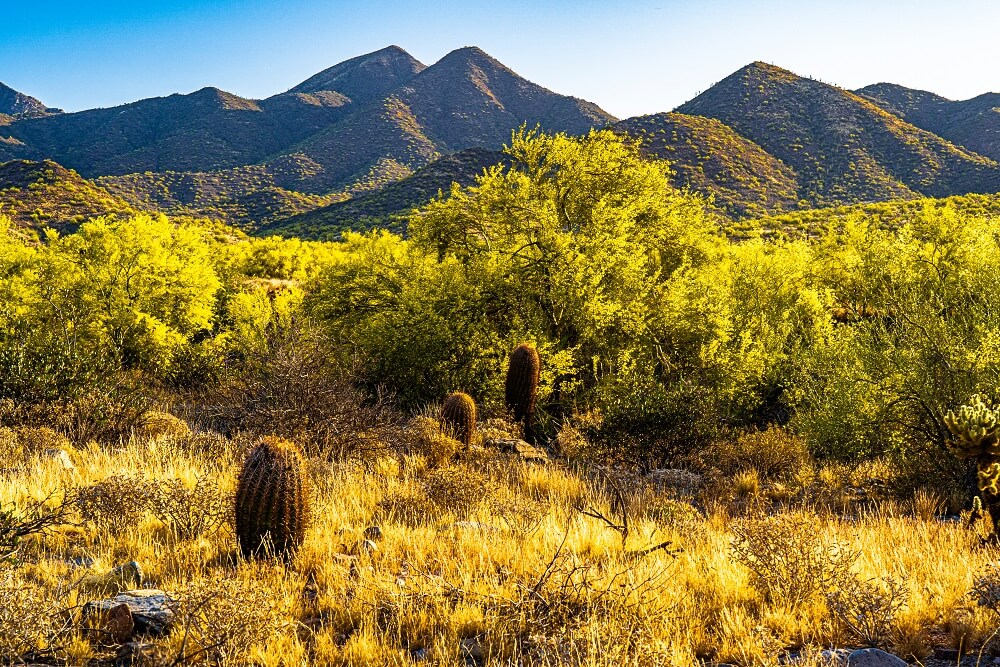
An incredible choice for xeriscapes or desert gardens, Yellow Palo Verde is a small deciduous tree with open spreading branches. A North American desert native, Yellow Palo Verde is moderately slow growing. It reaches 15 to 25 feet in height, depending on the availability of water.
Thriving in full sun in USDA zones 9-10, this yellow flowering tree blooms in late May. The flowers are pale yellow, and pea shaped. Small short golden-brown pods drape from the branches in mid-summer.
On the prickly side, wear protection when managing this very drought tolerant tree. It does well in, of course, gravelly, well-drained soil.
11. Ylang Ylang (Cananga odorata)
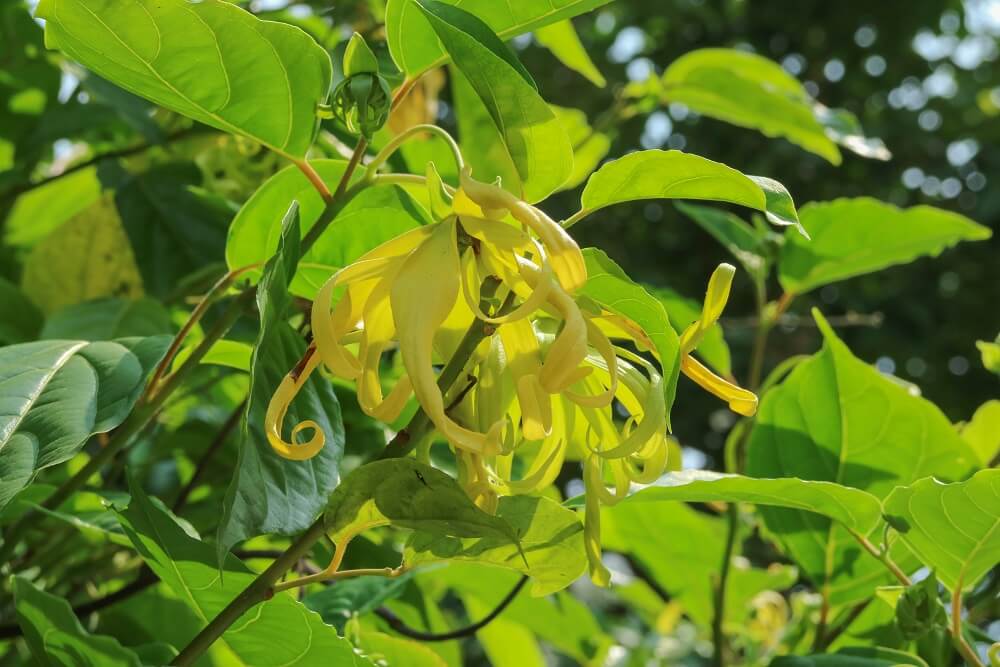
Once you are familiar with the seductive scent of Ylang Ylang, you will want to grow this stunning tree. Well known for its fragrance, Ylang Ylang also has many uses in the food industry, perfumery, and in natural medicine.
This incredible small tree grows in USDA zone 10 to 12 with its origins from the Philippines, Malaysia, and Indonesia. Preferring moist evergreen forest ecosystems, this delicious tree with yellow flowers grows up to 30 feet high.
The flowers are green when young, turning yellow, then yellowing brown. The drooping flowers grow in groups of 4 to 12, hanging in clusters. Each flower is 3 inches long and develop into 1-inch elongated green fruit.
12. Cootamundra Wattle (Acacia baileyana)
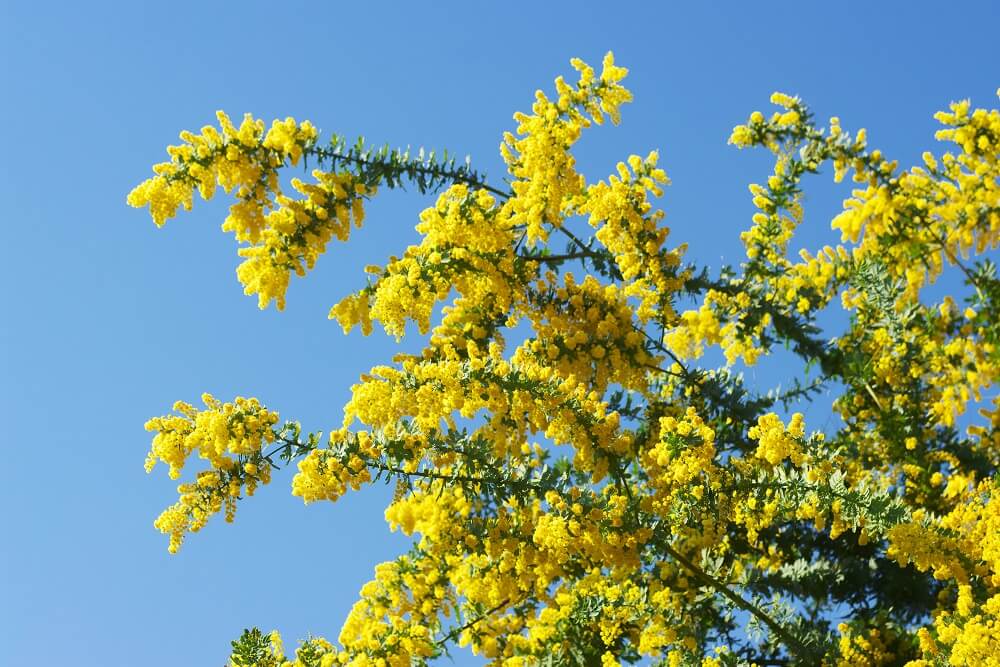
A native to New South Wales in Australia, this graceful evergreen blooms prolifically with masses of yellow flowers. The flowers develop into seedpods which hold long-lived seeds. Being drought resistant, Cootamudra Wattle, also known as Golden Mimosa, has the potential to naturalize or become weedy outside of its native range.
That said, it has achieved the Award of Garden Merit by the Royal Horticultural Society due to its fern-like, silvery grey leaves, and terminal branches smothered in yellow flowerheads in winter and spring.
In USDA hardiness zones 10 to 11, this tree with yellow flowers grows 20 to 30 feet tall and wide. An amazing addition to a Mediterranean themed garden, Cootamundra Wattle is useful on banks and borders as well.
13. Sydney Golden Wattle (Acacia longifolia)
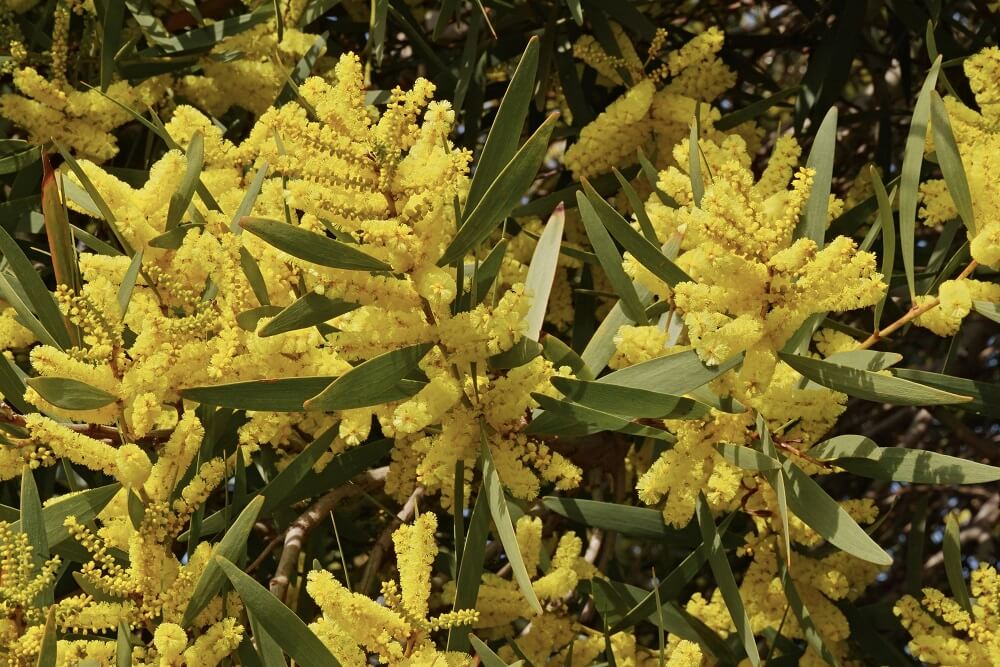
Sydney Golden Wattle has a fantastic display of bright yellow flowers. The entire plant is covered with abundant yellow, rod-shaped flowers followed by drooping, long-narrow seed pods. This small tree or large shrub grows 20 to 30 feet with smooth, grey bark with long, narrow 2-to-8-inch leaves. Flowering takes place from early winter to early spring.
In its native Australian habitat, seedpods and seeds are eaten by parrots. Bees and other pollinators are attracted to the flowers. This yellow-flowering tree is low maintenance. Sydney Golden Wattle is useful for erosion control and windbreaks.
14. Sweet Acacia (Vachellia farnesiana)

Sweet Acacia is a small tree with yellow flowers perfect for dry climates with little rainfall. The feathery, finely divided leaflets in soft green cover chocolate brown stems and their long, sharp thorns. Maybe not a great choice for children’s playgrounds, but Sweet Acacia is adored by wildlife and birds.
Pom-pom-shaped flowers are very showy and fragrant. The clusters of bright yellow globe-shaped flowers bloom throughout the year with their primary big blossom show in late winter. The small trees grow 15 to 25 feet with a rounded vase-shaped crown. Flowers produce 2-3-inch elongated seedpods which hold purplish-red seeds cherished by birds.
15. Yellow Flame Tree (Peltophorum pterocarpum)
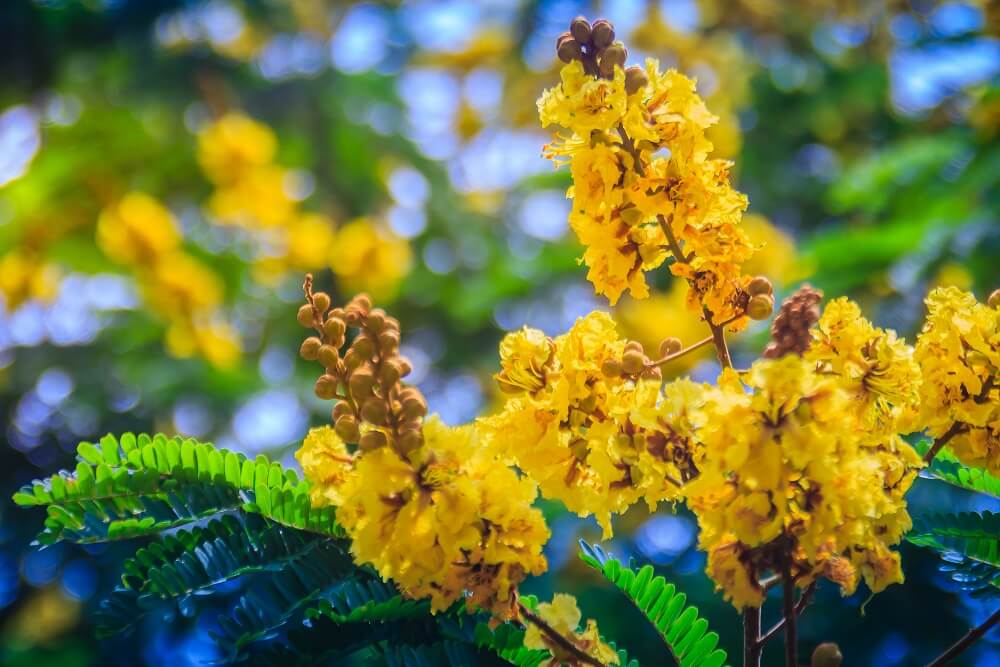
Yellow Flame Tree is a handsome yellow-flowering tree that yields an effortless tropical atmosphere. Hardy in USDA zones 10 to 11, Yellow Flame Tree makes an excellent shade tree or specimen tree in larger landscapes. Soft dappled shade is created by the delicate, feathery leaflets on the round, spreading canopy. Trees grow 40 to 50 feet tall and spread 30 to 50 feet wide.
At bloom time, the entire canopy is blanketed in clusters of yellow flowers. Deliciously scented, the terminal panicles emit a grape-like perfume. Blooming from spring to fall, the very showy 12-to-18-inch flowering branches develop interesting seedpods. The seedpods decorate the tree with 4-inch-long copper pods.
16. Yellow Chain Tree (Laburnum)
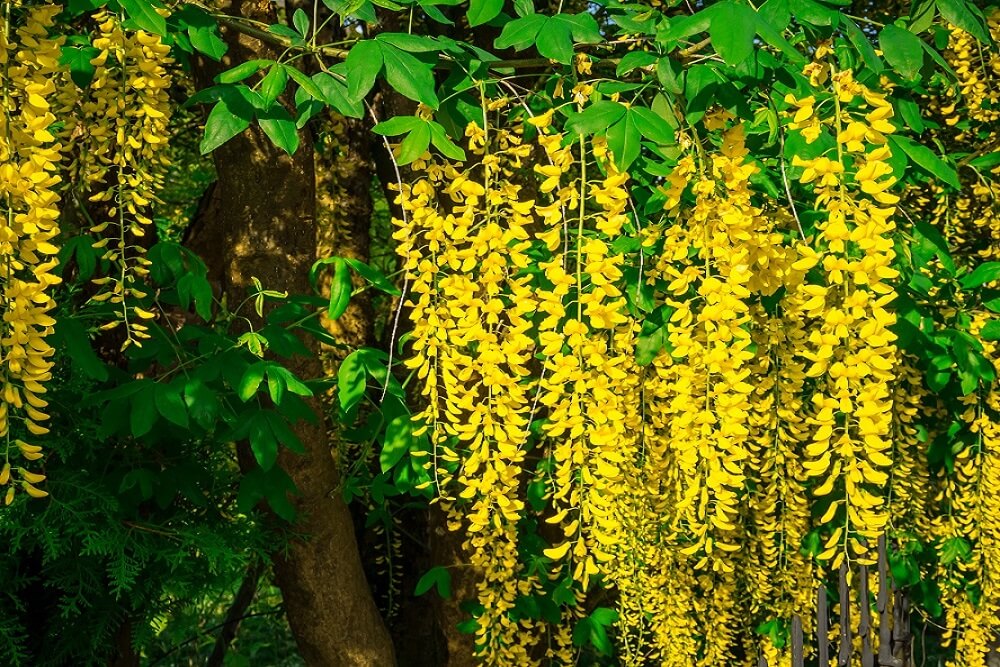
Yellow Chain Tree is a yellow dream version of Wisteria with its draping, dynamic 10-to-20-inch flower clusters. This yellow flowering tree prefers full sun. It grows 15 to 25 feet tall and 9 to 12 feet wide. The Yellow Chain Tree, also known as Bean Tree, originates in Europe. Hardy in USDA zones 7 to 9, this sweet-smelling tree is not edible. In fact, it is poisonous to humans and pets.
Against the backdrop of bright green three-pointed leaves, the Yellow Chain Tree blooms in spring. The fragrant pea-like blooms are stunning in long cascades. These develop into long, flat, fruit pods. When dry, the pods split open revealing their black seeds.
17. Yellow Silk Cotton Tree (Cochlospermum religiosum)
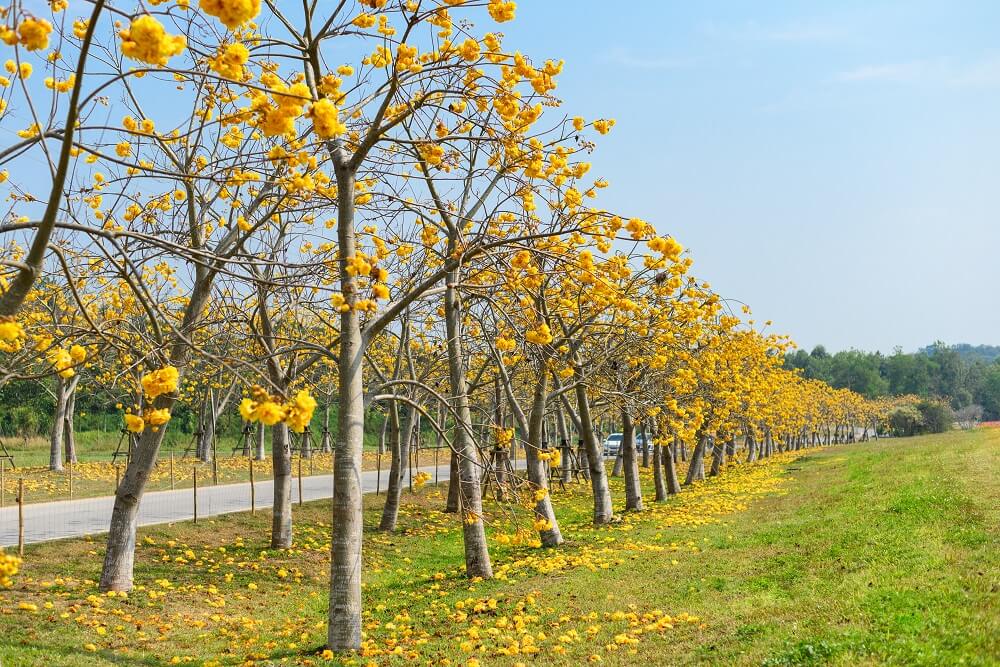
Yellow Silk Cotton Tree is also known as Buttercup Tree. This is due to its giant buttercup-like flowers. It gets its botanical label, religiosum, because the yellow flowers of Yellow Silk Cotton Tree are used as temple offerings. The Silk Cotton name comes from the cotton-like fluff found in its seed capsules.
This small tree grows up to 25 feet tall and prefers dry deciduous forest settings. The ornamental flowers are wonderfully fragrant, making Yellow Silk Cotton Tree an excellent choice for small gardens. A tropical tree originating in Southeast Asia, it is a wonderful park tree and suitable in palm gardens and as a street tree.
18. Yellow Oleander (Nerium oleander)
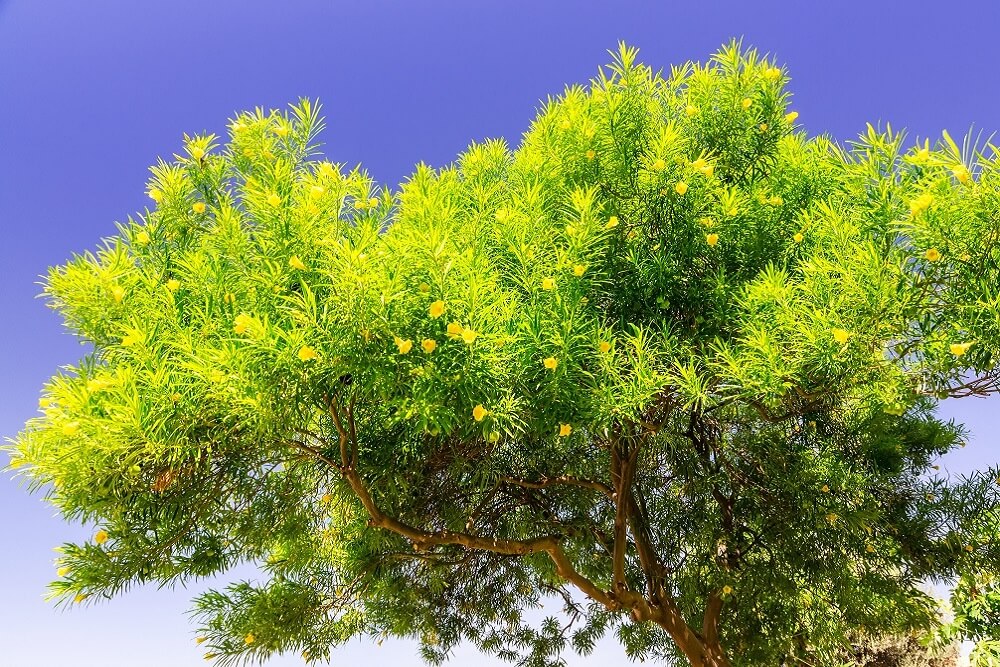
A highly drought tolerant tree, Yellow Oleander is an attractive small tree that also makes a great fast-growing screen and is stunning in mass plantings. Reaching heights of 10 to 18 feet, Yellow Oleander grows in USDA hardiness zones 9 to 11.
The fast-growing symmetrical crown has simple, opposite, dark green evergreen leaves that are 2 to 8 inches long. The leaves make the attractive fragrant blossoms pop at the end of branches. Blooming year round, Yellow Oleander blooms most prolifically in spring and fall. Blossoms mature to 3-to-6-inch seedpods. These are not showy. Removing seedpods encourages more gorgeous blooms.
19. Blue Paloverde (Parkinsonia Florida)
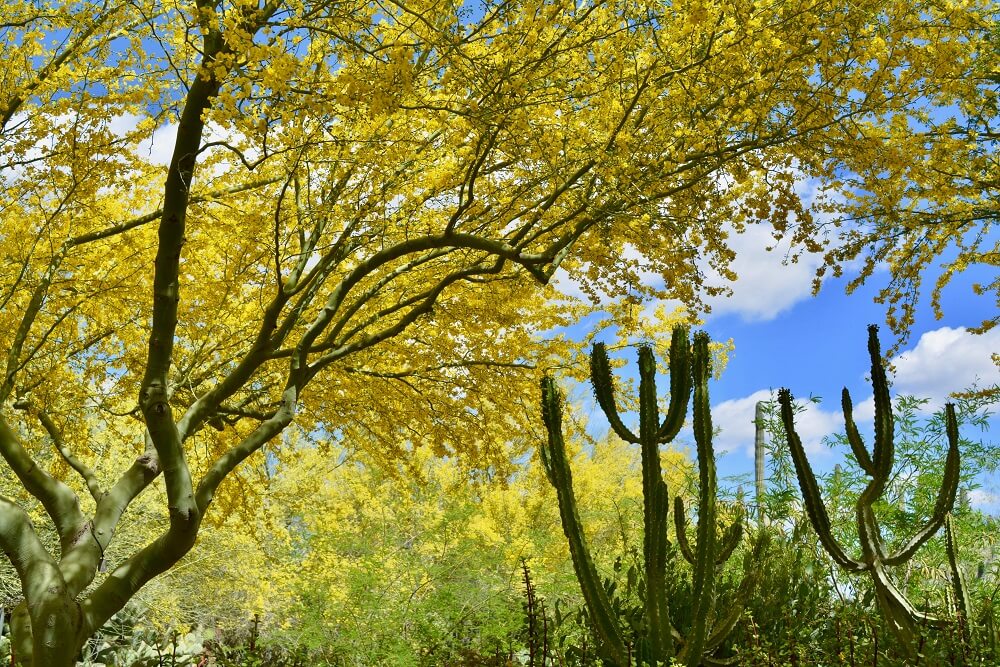
Blue Paloverde is a rounded spreading desert tree native to California, Nevada, and Arizona. Masses of lemon-yellow flowers bloom in clusters from March to May. The flowers support bees and seeds are a food source for birds and rodents.
Perfect for drought tolerant xeriscapes, this structural wide spreading medium sized desert tree prefers arid and dry landscapes. Blue Paloverde grows 30 feet tall and wide and is spiney and leafless most of the year. The small bluish green compound leaves drop at times of drought, allowing this tree to be a great choice where water conservation is important.
The entire tree is clothed in 2-to-4-inch lemon yellow flowers during bloom time. Subsequent fruit pods are brown and 2 to 3 inches long.
20. California Flannel Bush (Fremontodendron californicum)
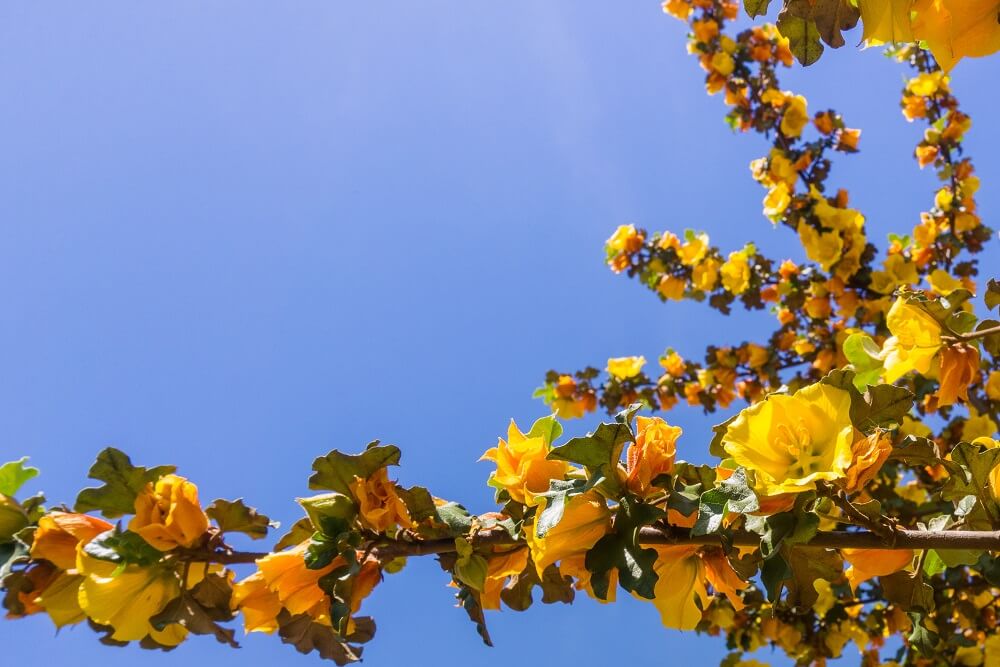
A spectacular broadleaf evergreen tree with yellow flowers, California Flannel Bush has showy yellow flowers in spring. Attractive to butterflies, this tree is native to California, western Arizona, and northern Baja California.
A drought tolerant tree, California Flannel Bush grows 8 to 18 feet tall in USDA hardiness zones 8 to 10. Thriving in full sun, it blooms from May to June. The late spring to early summer yellow flowers are large and saucer shaped. The evergreen leaves have three lobes and are 4 inches long. The dull green leaves and post-flowering seed capsules are covered with fine hairs that feels like flannel, hence the common name. Not so soft though, contact may cause skin irritation in some people.
21. Yellow Silk Floss Tree (Ceiba Speciosa)
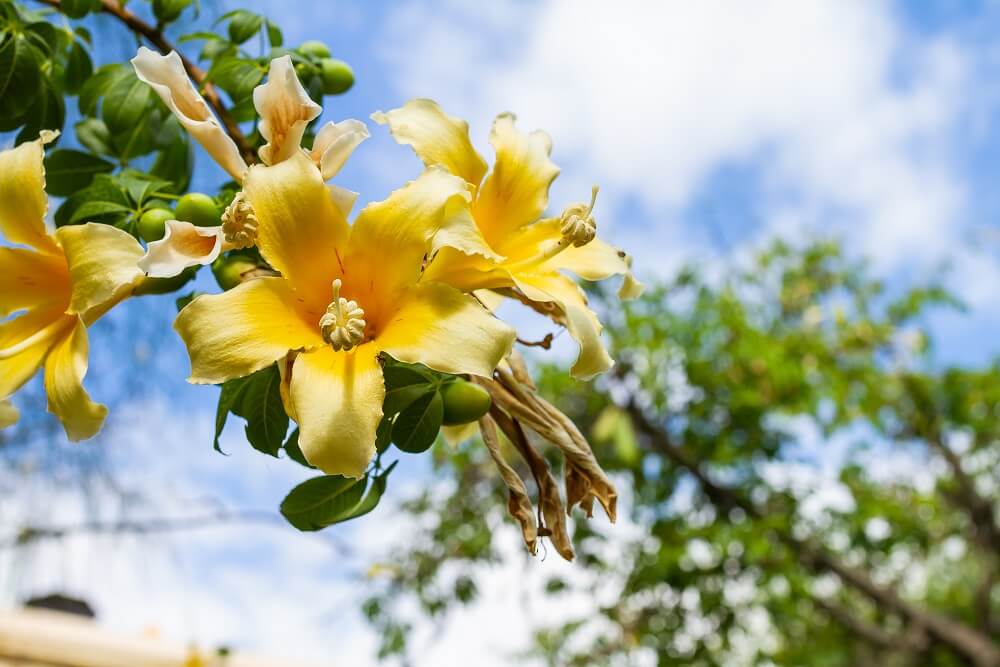
Yellow Silk Floss Tree is a stunning tropical tree originating from South America. The 50-foot tree takes pride of place on streets in parts of California and Florida. Thriving in USDA hardiness zones 9 to 11, this fall-blooming tree with yellow flowers blooms from October to November in the northern hemisphere.
Related to Baobab trees, mature trees are armed with thick, conical, sharp prickles, proving beautiful things need protection. The 6-inch flowers have 5 petals and look like hibiscus or daylily. They are incredibly attractive to pollinators and hummingbirds. Avocado-like fruits are 8-inch-long capsules containing black seeds the size of beans. Surrounding the beans is a fluffy cottony mass that can be collected to use as a silk-like stuffing.
[wp-faq-schema title=”Frequently Asked Questions About Trees with Yellow Flowers” accordion=1]21 Sunshine-Inspired Trees with Yellow Flowers to Warm Up The Garden
Yellow-flowering trees share many attributes, like attracting pollinators. There are differences though. Some thrive in desert conditions, like Cootamundra Wattle. Others require more moisture such as American Basswood.
With an abundance of options, choosing trees with yellow flowers is an excellent way to bring joy and happiness to the landscape. Finding out about the growing conditions for the area where you want to plant yellow-flowering trees is one way to help you choose.
For the best success, find trees that not only have the luminous yellow flowers you desire, but also grow well in your environment. Trees native to your area are always a great place to start. But there are excellent trees that have been introduced from around the world that make stunning additions to the landscape too.

